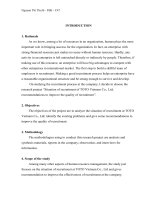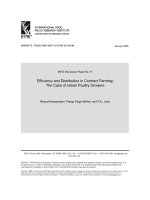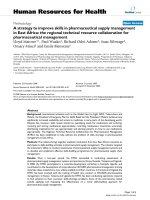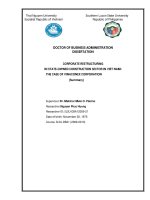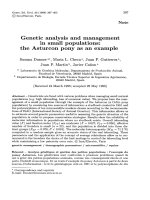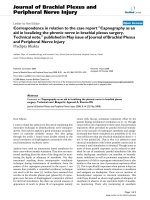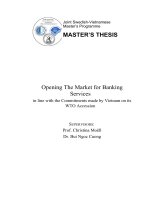Strategies of marketing management in container transportation the case of OOCL (Vietnam) co.,ltd
Bạn đang xem bản rút gọn của tài liệu. Xem và tải ngay bản đầy đủ của tài liệu tại đây (1.1 MB, 104 trang )
MBA Thesis Report Dec 2006 MMCVFB Intake 6
Written by Tran Phuoc Hiep
P
age i
CONTENTS
ACKNOWLEDGEMENT .
ABBREVIATIONS V
CHAPTER 1: INTRODUCTION 1
1.1 INTRODUCTION 1
1.2. PROBLEM STATEMENT 1
1.3 RATIONAL OF RESEARCH 2
1.4 RESEARCH METHODOLOGY 2
1.5 THE SCOPE AND LIMITATION OF RESEARCH 4
1.5.1 Scope of study 4
1.5.2 Limitation 5
CHAPTER 2: LITERATURE REVIEW 6
2.1 LITERATURE REVIEW ON SERVICES MARKETING AND MANAGEMENT 6
2.1.1 Definition of services 6
2.1.2 Characteristics of services 6
2.1.3 Classification of the Service 7
2.1.4 What is Services Marketing 8
2.2
LITERATURE REVIEW ON SHIPPING SERVICE AND TRANSPORTATION MARKETING 8
2.2.1 Definition of shipping service and containerized transportation 8
2.2.2 What is transportation marketing 9
2.3 LITERATURE REVIEW ON MARKETING STRATEGY AND MARKETING MIX 9
2.3.1 Marketing strategy 9
2.3.2 Developing marketing strategy 10
2.3.3 Targeting a market 11
2.3.4 Strategic Marketing with marketing mix 11
2.3.5 Logical steps in strategic marketing planning 12
2.3.6 SWOT analysis 12
CHAPTER 3: OVERVIEW OF CURRENT SHIPPING MARKET AND MARKETING
STRATEGY FOR OOCL (VIETNAM) CO., LTD 14
3.1
WORLD SHIPPING SERVICE HIGHLIGHTS 14
3.2 VIETNAM ECONOMY REVIEW 18
3.2.1 Gross Domestic Product (GDP) 18
3.2.2 Foreign Direct Investment 18
3.2.3 Overview on Vietnam Import Export activities 20
3.3
INTRODUCTION OF OOCL GROUP AND OOCL (VIETNAM) 24
3.4 OVERVIEW OF VIETNAM’S CURRENT SHIPPING MARKET AND OOCL POSITION 26
3.4.1 Overview of Vietnam containerized market 26
3.4.2 Transpacific Trade (TPT) 28
3.4.3 Asia Europe Trade (AET) 31
3.4.4 Intra Asia Trade (IAT) 34
3.4.5 Australian Trade (AUT) and others 36
3.4.6 OOCL (Vietnam) sales performance 36
CHAPTER 4: RESULTS AND DISCUSSION OF CUSTOMERS’ SURVEY 40
4.1
METHODOLOGY 40
4.2 RESULTS OF SURVEY AND DISCUSSION ON FINDINGS 41
MBA Thesis Report Dec 2006 MMCVFB Intake 6
Written by Tran Phuoc Hiep
P
age ii
4.2.1 Customers’ preference on shipping service 41
4.2.2 Customers’ satisfaction on OOCL service 43
4.2.2.1 Sample profile 43
4.2.2.2 Evaluation on OOCL services 44
4.2.3 Open-ended questions 48
4.3 SWOT ANALYSIS ON OOCL (VIETNAM) 49
4.3.1 Strengths 49
4.3.2 Weaknesses 50
4.3.3 Opportunities 51
4.3.4 Threats 52
CHAPTER 5: CONCLUSION AND RECOMMENDATION ON EXTENDED
MARKETING MIX FOR OOCL (VIETNAM) 53
5.1
TARGET FOR OOCL (VIETNAM) IN NEXT 5 YEARS 53
5.2 EXPANDED MARKETING MIX FOR OOCL (VIETNAM) 54
5.2.1 Product 54
5.2.1.1 Short haul vessel service 54
5.2.1.2 Long haul vessel services 55
5.2.2 Price 60
5.2.2.1 In long haul service 60
5.2.2.2 In short haul service 61
5.2.3 Place – Distribution 61
5.2.4 Promotion 62
5.2.5 People 63
5.2.5.1 Short training at work 63
5.2.5.2 Outside training 65
5.2.6 Physical evidence 65
5.2.7 Process 65
CONCLUSION 68
APPENDICES 69
MBA Thesis Report Dec 2006 MMCVFB Intake 6
Written by Tran Phuoc Hiep
P
age iii
LIST OF TABLES
Table 1 - Evolution of carriers operated fleet and market share year 2000 - 2006 17
Table 2 - GDP growth by year 18
Table 3 - Foreign Direct Investment by country & counted up to 20 December 2005. 19
Table 4 - Top Commodities Import Y2005 with associated value 20
Table 5 - Top Commodities Export Y2005 with associated value 21
Table 6 - Top countries import from 2000 to 2005 with associated value 22
Table 7 - Top countries export from 2000 to 2005 with associated value 23
Table 8 - Vietnam overall market volume and OOCL volume year 2005 27
Table 9 - Carriers volume and relative market share ex Vietnam to the United State, year 2005 vs
year 2004 29
Table 10 - Top commodities of market vs OOCL share in first half 2005 vs first half 2006 30
Table 11 - Y2005 Vietnam market volume of FEFC members to Eastern Europe (TEU) 32
Table 12 - Y2005 Vietnam market volume of FEFC members to Mediterranean area (TEU) 33
Table 13 - Year 2005 IADA member lifting from Vietnam 35
Table 14 - Lifting review of OOCL (Vietnam) Y2005 Vs Y2004 36
Table 15 - OOCL (Vietnam) review on revenue in year 2005 vs 2004 37
Table 16 - Target for OOCL (Vietnam) to year 2010 53
Table 17 - The increase level for each trade year after year from 2005 to 2010 54
MBA Thesis Report Dec 2006 MMCVFB Intake 6
Written by Tran Phuoc Hiep
P
age iv
LIST OF FIGURES
Figure 1 - GPD growth year 2000 to year 2005 18
Figure 2 - Top Ten Foreign Direct Investment countries with associated value 19
Figure 3 - Top Commodities Import Y2005 with associated value 21
Figure 4 - Top Commodities Export Y2005 with associated value 22
Figure 5 - Top countries import from 2000 to 2005 with associated value 23
Figure 6 - Top countries export from 2000 to 2005 with associated value 24
Figure 7 - Organization chart of OOCL (Vietnam) 25
Figure 8 - Service coverage of OOCL (Vietnam) 26
Figure 9 - Total Vietnam volume year 2005 27
Figure 10 - OOCL (Vietnam) lifting review by trade year 2005 37
Figure 11 - OOCL (Vietnam) lifting review year 2005 vs year 2004 37
Figure 12 - OOCL (Vietnam) revenue review by trade year 2005 38
Figure 13 - Long haul customers sample 41
Figure 14 - Short haul customers sample 42
Figure 15 - Freight control ratio of OOCL vs market 44
Figure 16 - Customer satisfaction toward OOCL long haul service 45
Figure 17 - Customer satisfaction toward OOCL short haul service 46
Figure 18 - Performance of different departments in long haul service 46
Figure 19 - Performance of different departments in short haul service 47
Figure 20 - Area need improvement first – long haul 47
Figure 21 - Areas need improvement – short haul 48
Figure 22 - SCX (South China Express) service 55
Figure 23 - PNX (Pacific North Express) service 56
Figure 24 - AEX (Asia East Coast Express) service 56
Figure 25 - EU1 (Europe 1) service
Figure 26 - EU2 (Europe 2) service 58
Figure 27 - EUM (Europe Mediteranian) service 58
Figure 28 - Loop A (Australia) service 59
Figure 29 - Loop B (Australia) service 59
Figure 30 - Shipment life-cycle 66
Figure 31 - Business Process Flow Overview within OOCL 67
MBA Thesis Report Dec 2006 MMCVFB Intake 6
Written by Tran Phuoc Hiep
P
age v
ABBREVIATIONS
OOCL: Orient Overseas Container Line
TEU: Twenty feet Equivalent Unit
FEU: Forty feet Equivalent Unit
TPT: Transpacific Trade
AET: Asia Europe Trade
AUT: Australian Trade
IAT: Intra Asia Trade
TSA: Transpacific Stabilization Agreement
FEFC: Far East Freight Conference
AADA: Asia Australia Discussion Agreement
IADA: Intra Asia Discussion Agreement
WTO: World Trade Organization
ASEAN: Association of South East Asia Nation
NAFTA: North America Free Trade Area
EU: Europe Union
APEC: Asia Pacific Economic Co-operation
SWOT: Strengths, Weaknesses, Opportunities, Threats
GDP: Gross Domestic Product
MBA Thesis Report Dec 2006 MMCVFB Intake 6
Written by Tran Phuoc Hiep
P
age 1
CHAPTER 1: INTRODUCTION
1.1 Introduction
The world’s markets nowadays have become increasingly “globalization”. To a large
extent, this reflects the fact that all countries are adjusting to strong trade exchange
pressures. These pressures are derived from international and regional trade agreements,
such as the World Trade Organization (WTO), the North American Free Trade
Agreement (NAFTA). There is also the development of other trading blocks like the
European Union (EU), the Association of South East Asian Nations (ASEAN), the Asia
Pacific Economic Co-operation (APEC), and the growth of Intra Asian Trade. These
trade policy initiatives have a common objective to open up new trading opportunities
and integrate countries into global economy.
The global economic integration relies upon efficiency and philosophy of logistics and
supply chain management. Shipping industry in general and containerized transportation
in particular plays a very important role in the logistics world. It is indispensable in the
supply chain management process. With the long history of shipping industry, since 19
th
century for cargo and passenger transportation and then developed to containerized
transportation in late 1950s, containerized transportation nowadays proves to be the most
economic and safety transportation mode. It now occupies more than 90% of total cargo
volume transported worldwide
1
.
1.2. Problem Statement
Nowadays, Vietnam becomes a manufacturing and processing place of many foreign
companies due to low labor costs, natural resources and attractive investment
environment. Beside that, in the past ten years, Vietnam’s economy has achieved its
vision of sustainable and high quality growth of GDP which is around 8% yearly. These
elements have raised the import – export demands in the country and this is resulted to
fast growth of shipping industry in general and containerized transportation in particular.
Currently, most of the shipping lines have been present in Vietnam market, about 32
lines. However, most of carriers currently don’t have a specific marketing strategy for
Vietnam market or they just base on the marketing strategy from head quarter because:
1
MBA Thesis Report Dec 2006 MMCVFB Intake 6
Written by Tran Phuoc Hiep
P
age 2
- Vietnam is a new and small market for containerized transportation, majority of
Vietnamese exporters are selling under FOB basic which leave the shipping control to
consignee side.
- The government is still controlling on maritime transportation, so most of carriers
operating under agent contract or joint venture, resulted to some self-constraints in
carriers’ investment.
With the prospect of joining WTO, Vietnam market will be fully open for all service
industries including maritime service, carriers will invest heavily in Vietnam and the
market supply will increase significantly over the demand. Therefore, a specific
marketing strategy of carrier for local Vietnam market is the vital need for carriers’
development.
1.3 Rational of research
The research is to concentrate on analyzing marketing information and OOCL services
details and then giving suggestion on marketing strategy for OOCL (Vietnam) Co., Ltd in
Vietnam market.
The objective of the research, first of all, is to put the knowledge acquired in school into
a business practice. Specially, by applying the newest knowledge and methodology in
services marketing, both in terms of strategy setting and working experience, the research
aims at finding a proper marketing strategy for OOCL (Vietnam) Co., Ltd.
The research is prepared for the company management to take into consideration the
marketing mix to improve OOCL (Vietnam) position, achieving challenge target for
OOCL (Vietnam).
1.4 Research Methodology
The research is prepared basing on the combination of literature guidance, secondary data
analysis and field interview. Specifically, the methodology includes:
- Reviewing the literature as a guideline to have an optimal approach to the
research objective.
MBA Thesis Report Dec 2006 MMCVFB Intake 6
Written by Tran Phuoc Hiep
P
age 3
- Secondary data obtained from company finance report and shipping line
conferences were analyzed in order to have an overview of shipping industry
worldwide and Vietnam in particular.
- Primary data was collected from direct interview with customers and specialist in
this field. Running SPSS program to analyze the data. Transfer the results into
comment and conclusion of the correlation between factors.
- SWOT analyses method.
- Finally, based on all the results acquired from previous steps together with
corporation overall strategy, an extended marketing mix for the company OOCL
(Vietnam) Co., Ltd. is recommended.
MBA Thesis Report Dec 2006 MMCVFB Intake 6
Written by Tran Phuoc Hiep
P
age 4
1.5 The scope and limitation of research
1.5.1 Scope of study
The study focuses mainly on containerized transportation in Ho Chi Minh market. Study
customers’ behaviors, expectation and demand on company’s services.
Provide recommendations and solutions to assist with the company marketing strategy
and development orientation.
Objectives of the study
OOCL Vietnam introduction and internal analysis,
basing on secondary data reference
Review of relevant Literature
Redefine corporate objectives
Marketing survey as primary data collection
Generating marketing strategy options
Analysis of data findings (SPSS) and SWOT analysis
Business environment and external analysis, basing on
secondary data reference
Conclusion and recommendation
MBA Thesis Report Dec 2006 MMCVFB Intake 6
Written by Tran Phuoc Hiep
P
age 5
1.5.2 Limitation
The study just purely looks into containerized transportation (a factor among logistics
and supply chain management) and the marketing strategy for OOCL (Vietnam) Co.,
Ltd It could not expound fully the role of containerized transportation in logistics
management because of time limitation. Beside that my knowledge is limited that may
affect on result of study, therefore, the study would mention on some main aspects and
routes of the carriers only, and it is synoptically. However, the thesis is a cornerstone for
my further study in the field and I believe that my suggestions are useful for the company
in developing its presence in Vietnam market for the next 10 years.
MBA Thesis Report Dec 2006 MMCVFB Intake 6
Written by Tran Phuoc Hiep
P
age 6
CHAPTER 2: LITERATURE REVIEW
2.1 Literature review on Services marketing and Management
2.1.1 Definition of services
There are many definitions of what constitutes a service. In the simplest term,
services are deeds, processes and performance. Under the theories of Johnson, MacMilan
& Allen, “compliance services can include everything from compliance inspections to
employee monitoring, process ventilation efficiency studies and employee training.”
2
Modern definitions of services focus on the fact that a service in itself produces no
tangible output, although it may be instrumental in producing some tangible output. “A
service is any activity or benefit that one party can offer to another which is essentially
tangible and doesn’t result in the ownership of anything. Its production may or may not
be tied to a physical product”
3
The modern definition recognizes that most products are a combination of both goods
elements and services elements. In some case, service element will be the essential
element of the services while in other cases the services will simply support the provision
of tangible goods.
Combining simple and modern definitions, we have fairly full definition of services
as follow:
“Services include all economic activities whose output is not a physical products or
construction, is generally consumed at the time it is produces and provides added value in
forms (such as convenience, amusement, timeless, comfort and health) that are essential
intangible concerns of its first purchasers”
4
2.1.2 Characteristics of services
There are several characteristics that services different from goods. Basically, there
are at least such differences, as follow:
1. Customer does not want to obtain ownership of services
2. Service products are intangible performance.
3. There is greater involvement of customers in the “production” process
4. Other people may be part of the product.
5. There is greater variability in operational input and output.
6. Many services are difficult for customers to evaluate.
7. There is typically absence of inventories.
8. The time factor is relatively more important.
2
Valerie A Zeithaml and Mary Jo Bitner, “Services Marketing”, Mc Graw-Hill International; 5
th
edition
3
Andrian Palmer, “Principles of services marketing”, McGraw-Hill International; 3
rd
edition; 2001
4
James Brian Quinn, Jordan J Baruch and Penny Cushman Paquette “Technology in Services”, Scientific
American No.257 on 6
th
December 1987; page 50-58
MBA Thesis Report Dec 2006 MMCVFB Intake 6
Written by Tran Phuoc Hiep
P
age 7
9. Delivery system may involve both electronic and physical channels
5
More academically, but with similar meanings, services hold the six following
features:
1. Intangibility – the invisibility of services. This leads to the importance of
materializing the services delivered, the difficulty in measuring their quality, the
importance of managing customers’ expectation and perception and the difficulty in
protecting innovations.
2. Perish-ability, which means that services, unlike goods, cannot be kept in stock
over time. In other words, services are more sensitive than physical goods in demanding
changes or variations.
3. Transferability. Ideas of operating a service can be copied from other different
service.
4. Heterogeneity in delivery and consumption. This leads to the difficulty in
managing and controlling the service quality, improving productivity, standardizing
operations and thus, makes it often possible to tailor the services to customers’ specific
needs.
5. Simultaneity of production and consumption. Therefore, services cannot be
analyzed prior to purchase and require more direct customer-staff and customer-customer
contacts. Since customers must be involved in any work being performed, there are more
constraints in scheduling, locating and planning the services.
6. Cultural specificity. It is more important for service operators than manufacturers
to take into account the cultural context of the business. In other words, it is accepted that
service is more culture-sensitive than any other sectors ever realized and studied.
6
2.1.3 Classification of the Services
7
The service sector or the service industry, is one of the three main industrial categories of
a developed economy, the others being the secondary industry (manufacturing and
primary goods production such as agriculture), and primary industry (extraction such as
mining and fishing).
The tertiary sector of industry involves the provision of services to other businesses as
well as final consumers. Services may involve the transport, distribution and sale of
goods from producer to a consumer as may happen in wholesaling and retailing, or may
involve the provision of a service, such as in pest control or entertainment. The goods
may be transformed in the process of providing the service, as happens in the restaurant
industry. However the focus is on people interacting with people and serving the
customer rather than transforming physical goods. For the last 20 years there has been a
substantial shift from the other two industry sectors to the Tertiary Sector in
industrialised countries.
5
Lovelock, C.H. and Wright, L.K., “ Principles of Service Marketing and Management”, Prentice Hall,
1999
6
Karen P. Goncalves; “Services Marketing – A strategic approach”, Prentice Hall International Inc., 1
st
edition, 1998
7
MBA Thesis Report Dec 2006 MMCVFB Intake 6
Written by Tran Phuoc Hiep
P
age 8
The service sector consists of the "soft" parts of the economy such as insurance, tourism,
banking, retail and education. Others include:
• Franchising
• Restaurants
• Retailing
• Entertainment, including the Record industry, Music industry, Radio, Television
and Movies.
• News media
• Leisure industry
• Transport
• Healthcare
• Consulting, Investment and Legal advice and services.
2.1.4 What is Services Marketing
Services marketing is marketing based on relationship and value. It may be used to
market a service or a product.
Marketing a service-base business is different from marketing a product-base business.
There are several major differences, including:
1. The buyer purchases an intangible
2. The service may be based on the reputation of a single person
3. It's more difficult to compare the quality of similar services
4. The buyer cannot return the service
5. Service Marketing mix adds 3 more P's i.e. People, Physical evidence, Process.
When one markets a service business, one must keep in mind that reputation, value,
delivery of service and follow-through are keys to a successful venture.
8
2.2 Literature review on shipping service and transportation marketing
2.2.1 Definition of shipping service and containerized transportation
9
Shipping is basic process of transporting goods and cargo. Virtually every product ever
made, bought, or sold has been affected by shipping. Despite the many variables in
shipped products and locations, there are only three basic types of shipments: land, air,
and sea.
In this thesis, we will focus on shipping as sea transportation, the most popular form of
shipping. Most cargo transport is by sea rather than by air transport because sea transport
8
Levitt, T. "Managing intangible products and product intangibles", Harvard Business Review, May-June,
1981, pp.94-102
9
Marc Levinson, The Box, How the Shipping Container Made the World Smaller and the World Economy
Bigger (Princeton Univ. Press 2006).
MBA Thesis Report Dec 2006 MMCVFB Intake 6
Written by Tran Phuoc Hiep
P
age 9
can be cheaper and less restrictive to size, quantity, weight, and type of freight. Air
transport is usually reserved for products which must be sent within a certain time frame.
Containerization is an important element of the logistics revolution that changed freight
handling in the 20th century. Malcolm McLean claimed to have invented the shipping
container in the 1930s in New Jersey. Then a truck owner-operator, McLean explained
that while sitting at a dock waiting for cotton bales to be unloaded from his truck then
reloaded onto a ship, he realized that the truck itself (with some minor modifications)
could be transferred much more efficiently. Years later, McLean founded Sea-Land
Corporation, and his first container ship left Port Newark for Houston, Texas on April 26,
1956, carrying 58 trailers.
Containerization revolutionized cargo shipping. Today, approximately 90% of cargo
moves by containers stacked on transport ships. As of 2005 some 18 million containers
make over 200 million trips per year, there are ships that can carry over 6,000 TEU, and
designers are working on freighters capable of 13,000 TEU. It has even been predicted
that at some point, container ships will be constrained in size only by the Straits of
Malacca, one of the world's busiest shipping lanes.
2.2.2 What is transportation marketing
Transportation marketing
10
is an effective marketing tool to manage the industry and to
solve the following issues:
- To study the overall market of the transportation services.
- To identify the need of quality and quantity of the transportation.
- To give the transportation plan.
- To identify the satisfaction of the transportation needs.
- To impact actively on the transportation market to increase the need.
- To analyze the activities of each means of transportation.
- To identify the transportation cost, freight, service charges and to set the
revenue and the profit for each enterprise.
- To enhance the service quality, to improve the relationship between the
enterprises and clients.
- To develop the advertising and promotion in the transportation industry.
2.3 Literature review on Marketing strategy and Marketing Mix
2.3.1 Marketing strategy
Marketing strategy
11
is marketing starts with market research, in which needs and
attitudes and competitors’ products are assessed and continues through into advertising,
promotion, distribution, and, where applicable, customer servicing and repair, packaging,
and sales and distribution.
10
Dr. Nguyen Huu Ha, “Marketing in transportation industry”, Statistic Publisher, 1
st
edition, 1999.
11
MBA Thesis Report Dec 2006 MMCVFB Intake 6
Written by Tran Phuoc Hiep
P
age 10
A marketing strategy
12
serves as the foundation of a marketing plan. A marketing plan
contains a list of specific actions required to successfully implement a specific marketing
strategy. An example of marketing strategy is as follows: "Use a low cost product to
attract consumers. Once our organization, via our low cost product, has established a
relationship with consumers, our organization will sell additional, higher-margin
products and services that enhance the consumer's interaction with the low-cost product
or service."
A good marketing strategy should integrate an organization's marketing goals, policies,
and action sequences (tactics) into a cohesive whole. The objective of a marketing
strategy is to provide a foundation from which a tactical plan is developed. This allows
the organization to carry out its mission effectively and efficiently.
2.3.2 Developing marketing strategy
Developing a marketing strategy involves two related tasks, selecting a target market in
which the company operates and developing marketing mix in each target. When you
target a market you need to develop a differentiation and position strategy for that
market. Once the company decides its product positioning, it must initiate new-product
development, testing and launching. Different decision tools and controls are needed at
each sate of the new-product-development process. After launch, the new product
strategy will have to be modified at different stages in the product life cycle which are
introduction, growth, maturity and decline. Furthermore, strategy choice will depend on
whether the firm plays the role of a market leader, challenger, follower, or niches.
Finally, strategy takes into account in changing global opportunities and challenges.
There are six major factors that should be identified in determining which strategy might
be more appropriate
13
.
- The size of the market. If the market or market segment served is already small,
further segmentation through a market segmentation strategy may reduce the potential
number of customers to a degree that a market segmentation strategy is unattractive.
- Consumer sensitivity. For very basic necessities or services, consumers maybe
insensitive to product differences. For the more elastic products, the level of sensitivity is
high making product differentiation strategy appropriate.
- Product life cycle. Goods or services in different phases of the life cycle may find
one strategy more successful than the other.
- Type of product. As mentioned previously, it is nearly impossible to implement
product differentiation strategy for some kinds of basically alike products where
differentiation is difficult to be created and communicated or undesirable.
- Number of competitors. When there are a large number of competitors in the
market, it is much more difficult to differentiate a product. Thus, a large number of
competitors calls for a market segmentation strategy.
12
Kotler, P. and Amstrong, G., 1999, “Priciples of Marketing”, 8
th
edition, Prentice-Hall.
13
Lovelock, C.H. and Wright, L.K., “ Principles of Service Marketing and Management”, Prentice Hall,
1999
MBA Thesis Report Dec 2006 MMCVFB Intake 6
Written by Tran Phuoc Hiep
P
age 11
- Competitors’ strategies. When there are many competitors that are using market
segmentation strategy, it is advised that marketer choose market segmentation strategy in
which a particular market segment is picked up and resources concentrated.
2.3.3 Targeting a market
A target market consists of a group of customers. In targeting a consumer market, the
company needs to segment the market first. There are two bases of segmenting consumer
markets, consumer characteristics and consumer responses. These market segments
should be measurable, substantial, accessible, differentiable and actionable. Once the
company has identified its market-segment opportunities clearly, it must evaluate various
segments and decide how many and which ones to target.
2.3.4 Strategic Marketing with marketing mix
Marketing mix includes 4Ps standing for Product, Price, Promotion and Place. This
4Ps is very familiar to any marketer when it’s application is very popular. Apart from the
four above items, there are also other elements: People, Physical Evidence, Process and
Customer Service. The market mix expansion
14
is as follows:
- Products are the means by which organizations seek to satisfy consumer needs. A
product in this sense is anything which the organization offers to potential customers
whether it is tangible or intangible. The concerns of this part are physical features, quality
level, accessories, packaging, warranties, production lines and brandy.
- Pricing, Price mix decisions include strategic and tactical decisions about the
average level of prices to be charged, discount structures, term of payment and the extent
to which prices discrimination between different groups. Flexibility, price level, terms,
differentiation, discount and allowances would be the main factors of price mix.
- Promotion, promotion mix includes various methods of communicating the benefits
of a service to potential consumers. Four elements of this are advertising (target, media
types and copy thrust), sales promotion, public relations and personal selling (selection,
training and incentives).
- Place, place decisions refer to the channel types, exposures, intermediaries, outlet
location, transportation, storage and managing channel. It can be physical location
decisions, decisions about which intermediaries to use in making a service accessible to a
consumer and non-location decisions which are used to make services available.
- People, people are the vital element for most services in the marketing mix. When
production can be separates from the consumption, management can usually take
measures to reduce the direct effect of people on the final output as received by
customers.
- Physical evidence, the intangible nature of a service means that potential customers
are unable to judge a service before it is consumed, increasing the risk inherent in a
purchase decision.
- Processes, production processes are usually of little concern to consumers of
services where the consumers can be seen as a co-producer of the service.
14
Adrian Palmer, “The Principles of Services Marketing”, McGraw-Hill International, 3
rd
edition, 1998.
MBA Thesis Report Dec 2006 MMCVFB Intake 6
Written by Tran Phuoc Hiep
P
age 12
- Customer service, the meaning of customer service varies from one organization to
another. Within the service sector, it can be best described as the total quality of the
services.
2.3.5 Logical steps in strategic marketing planning
There are many models of the formal process, but most are based on the three-phase
structure articulated by Johnson and Scholes
15
- Where are we now? – The situation analysis, out of which alternatives become more
obvious. In the context of marketing planning this includes an external and internal audit.
- Where do we want to go? – Formulating objectives relating to the strategy
hierarchy, resulting in a hierarchy of objectives.
- How are we going to get there ? – Deciding the vehicle of strategy, this normally
includes the product/ market mix.
According to Stern
16
, a strategic marketing planning should include the following
steps:
- To determine company mission and goals followed by setting marketing objectives.
- To access market opportunities and state assumption. The inputs for the process
include social, technological, governmental, business and other environments.
- To generate strategies. In this step, several alternative strategies are introduced for
further consideration.
- To select the best strategies. This involves much of management decision.
- To program marketing mix.
- To detail the plan.
- To revise and have the plan approved.
- To communicate of the plan and implement it.
- To audit and adjust where necessary.
Stern suggests that the strategic marketing planning model should not be
implemented in a one-way approach. Where and when possible and necessary, certain
review and adjustment should be taken.
2.3.6 SWOT analysis
A SWOT Analysis
17
is a strategic planning tool used to evaluate the Strengths,
Weaknesses, Opportunities, and Threats involved in a project or in a business venture or
in any other situation requiring a decision. The required first step in SWOT analysis is
the definition of the desired end state or objective. The definition of objective must be
explicit and approved by all participants in the process. This first step must be performed
resources and possibly failure of the enterprise. In relation to objectives the following
15
Johnson and Scholes, Strategic Marketing: Cases, Concepts and Challenges, 1998, Prentice Hall.
16
Stern, M.E., 1996, marketing Planing: A System Approach, Mc Graw Hill
17
MBA Thesis Report Dec 2006 MMCVFB Intake 6
Written by Tran Phuoc Hiep
P
age 13
terms have been used in the literature: desired end states, plans, policies, goals,
objectives, strategies, tactics and actions. Definitions vary, overlap and fail to achieve
clarity. The following concept has been found useful. The items listed above may be
organized in a hierarchy of means and ends and numbered as follows: Top Rank
Objective (TRO), Second Rank Objective, Third Rank Objective, etc. From any rank, the
objective in a lower rank answers to the question "How?" and the objective in a higher
rank answers to the question "Why?" The exception is the Top Rank Objective (TRO):
there is no answer to the "Why?" question. That is how the TRO is defined. Once the
objective has been identified, SWOTs are discovered and listed. SWOTs are defined
precisely as follows:
Strengths are attributes of the organization that are helpful to the achievement of the
objective.
Weaknesses are attributes of the organization that are harmful to the achievement of the
objective.
Opportunities are external conditions that are helpful to the achievement of the objective.
Threats are external conditions that are harmful to the achievement of the objective.
Strengths and Weaknesses factors:
• Resources: financial, intellectual, location
• Customer Service
• Efficiency
• Competitive Advantages
• Infrastructure
• Quality
• Staff
• Management
• Price
• Distribution Channels and Hours of operations
• After sales service and Sales promotion techniques
• Transportation and Delivery time
• Diversified fields, Product line and multiple services/offers (Technical,
Commercial, Designing & Turnkey Projects etc )
Opportunities and Threats factors:
• Competitors' actions
• Economic conditions
• Interest rates
• Increasing market saturation
• Changes in laws and regulations
MBA Thesis Report Dec 2006 MMCVFB Intake 6
Written by Tran Phuoc Hiep
P
age 14
CHAPTER 3: OVERVIEW OF CURRENT SHIPPING MARKET AND
MARKETING STRATEGY FOR OOCL (VIETNAM) CO., LTD
3.1 World shipping service highlights
In the past ten years, containerized transportation keeps increasing on both scale and
quantity due to the increase in trade exchange from Far East and the non-stop competitive
on market share among carriers
18
.
According to BRS-Alphaliner data, a sea transport broker located in Paris, between
January 2000 and January 2006, the TEU (Twenty feet Equivalent Unit) capacity
deployed on liner trades has risen from 5,150,000 TEU to 9,135,000 TEU, i.e. a 77.4%
increase. It means that in order to simply keep their market shares during that period,
carriers had to increase their fleet capacities by 77.4%. Those which failed to invest, or
charter, enough to keep the pace have lost market share.
The accompanying graph shows the performances of a selection of carriers among the
TOP 30 lines. It is based on the ratio between market shares at 1st January 2000 and 1st
January 2006. For example, CSCL market share rose from 1.67% to 3.80%, i.e. an
increase of 126%.
Market shares are deducted from the existing on board TEU (Twenty feet Equivalent
Unit) capacities of carriers, compared with the total capacity effectively deployed on
liner trades (these figures take into account cellular ships, multipurpose ships and roro
ships which are effectively employed on regular liner services, and they do not include
ships which are not operated on liner trades, even if TEU fitted). The total market
capacity and the carriers’ market shares are computed daily by BRS-Alphaliner and can
be consulted in our TOP 100 page. The three rising stars of this decade so far are CMA
CGM, CSCL and Hapag-Lloyd.
CMA CGM logged a market share rise of 133%, with its share climbing from 2.4% to
5.6% during the past 6 years. Organic growth counts for more than 80% of this figure
while the 2005 purchase of Delmas contributes to less than 20%. At the same time,
CSCL has more than doubled its market share from 1.7% to 3.8%, only through organic
growth. As for Hapag-Lloyd, its market share grew from 2.0% to 4.5%. The 2005
purchase of CP Ships counts for around three quarters of this growth. Without the CP
Ships contribution, Hapag-Lloyd would have seen its market share growing from 2.0% to
2.5%.
MSC comes at the fourth place with a share which has almost doubled as it rose from
4.4% to 8.6%. During the period 2000-2006, MSC has climbed from the fifth rank to the
second rank in the TOP carriers’ league, with a trebling in fleet capacity.
Next comes the CSAV Group, with a share which has risen from 1.4% to 2.6%, partly
thanks to the purchase of Norasia in 2000 and the Norsul liner services in 2002, and
partly to organic growth.
18
MBA Thesis Report Dec 2006 MMCVFB Intake 6
Written by Tran Phuoc Hiep
P
age 15
Although it remains at the top slot in terms of fleet capacity, the AP Möller-Maersk
Group comes at the eighth position for market share growth, a rank achieved thanks to
the 2005 purchase of Royal P&O Nedlloyd which allowed it to boost its market share
from 12.5% to 18% overnight, corresponding to an increase of 51% compared with
January 2000. Prior to the PONL purchase, the Maersk market share had been stagnating
at around 12% since January 2000 (and incidentally, the PONL market share was
stagnating as well). Despite this huge jump, it’s still lagging behind MSC, its closest rival
in fleet capacity terms. Maersk is by far the largest carrier with a fleet reaching 1.66
million TEU, almost twice the size of MSC.
Some carriers with a strong regional bias are also doing well, although for them, the
concept of global market share is of low significance. IRIS Lines, Hamburg-Süd Group
and PIL have gained significant market shares in global terms, which also means that
their regional market shares has grown still stronger.
Hongkong based carrier Orient Overseas Container Line (OOCL) increase 4 rank from
16
th
to 12
th
with market share increase 13% compared to January 2005. OOCL choose the
strategy of “organic growth” within their internal capacity, not impacting by the trend of
merging of other giant carriers.
Two carriers heavily involved in feeder trades have also kept well the pace, RCL and Sea
Consortium. They managed to increase their market share by 4% and 10% respectively
(although for RCL, its efforts to develop its own common carrier services have also
helped).
Japanese lines NYK, MOL and K Line have managed to maintain more or less their
shares, and are no longer as expansive as they used to be.
Those who win market share get it of course at the expense of rivals. For example, the
Evergreen Group saw its market share diminished by 15%, down from 6.2% to 5.2%.
Evergreen was ranked in second position in 2000 with a fleet of 318,000 TEU. It has
since been relegated to the fourth slot despite a growth to 478,000 TEU.
COSCO Container Lines has seen its share decrease by nine points since 2000 but is now
strongly reacting and this slide has come to a halt over the past 18 months. It is now on
the rising slope again, an interesting trend as it has been listed on the HKSE in June
2005.
Korean carriers Hanjin Shipping (including Senator Linie) and Hyundai Merchant
Marine have suffered of the post-1997 financial crisis. They were at the time the shipping
divisions of heavily indebted chaebols, which had to slash expenses. The result is that
new building programs have been minimal. They are at least still there, which is not the
case of independent compatriot Choyang Line, which disappeared in 2001.
Hongkong based carrier Orient Overseas Container Line (OOCL) increase 4 rank from
16
th
to 12
th
with market share increase 0.6%. OOCL choose the strategy of “organic
MBA Thesis Report Dec 2006 MMCVFB Intake 6
Written by Tran Phuoc Hiep
P
age 16
growth” within their internal capacity, not impacting by the trend of merging of other
giant carriers.
A few regional players have also loosed grip. UASC and MISC have each one lost 45%
in relative importance. UASC did not invest, and it has waited March 2005 to launch a
construction program for eight ships of 6,800 TEU. MISC has put the emphasis on
energy transportation and has not received a single containership since the late 1990s,
and its order book is limited to 16,000 TEU. Africa specialist Delmas has seen its market
share dropping by 40% during the 5.5 years preceding its purchase by CMA CGM.
Delmas has been hit by the low growth characterizing Africa and by a lack of interest by
parent company Bolloré.
Among smaller carriers, Costa Container Lines built-up a consistent market share on
American trades, boosting its overall presence from insignificant to 0.4% while the China
Navigation Co (Swire Group) strengthened its presence on the South Pacific markets. On
their side, Chinese regional carriers SYMS and SITC have made their place. SYMS has
even entered the TOP 30 in December with its fleet passing the 32,000 TEU mark.
SYMS launched its first international services in 1999.
It is also interesting to see the pace at which the concentration is going. The Top 10
carriers had a combined market share of 49.3% in January 2000. It now stands at 60%
(The Top 10 fleet has more than doubled, from 2.54 million TEU to 5.48 million TEU).
Their combined market share has thus risen by 21.7%. At the other end of the scale, the
fleets of carriers ranked 51 to 100 has stagnated at just under 400,000 TEU, with a
resulting loss of almost 45% in market share (from 7.7% in 2000 to 4.3% in 2006).
MBA Thesis Report Dec 2006 MMCVFB Intake 6
Written by Tran Phuoc Hiep
P
age 17
Table 1 - Evolution of carriers operated fleet and market share year 2000 - 2006
Source:
MBA Thesis Report Dec 2006 MMCVFB Intake 6
Written by Tran Phuoc Hiep
P
age 18
3.2 Vietnam Economy Review
3.2.1 Gross Domestic Product (GDP)
The annual GDP growth is contributed from the development of many field. And it
definitely & correlatively create the demand of transportation & logistic services since it
is a indispensable trade mean of voluntary exchange of goods, services, assets or money
between person or organization.
Vietnam economy, with steady & sustainable growth of GDP 2000 - 2005 range from
6.79% to 8.4%, has gained the second highest economic growth in Asia after China.
together with the government target GDP growth 2006 at 8.00 %. It is stated &
forecasted this economic growth momentum will maintain 7.0%-8.0% annually to keep
pace with government’s five year plan 2006- 2010. Most likely the economy growth is
achievable and sustainable. And a very dialectical reasoning will pull the growth & the
demand of transportation & logistic services as well as reflect the grow-up of the
shipping industry.
Table 2 - GDP growth by year
Year 2000 2001 2002 2003 2004 2005
GDP 6.79 6.89 7.04 7.24 7.77 8.4
Source: Vietnam Economic Times
Figure 1 - GPD growth year 2000 to year 2005
0
5
10
% GDP Growth
Year
GDP
GDP
6.79 6.89 7.04 7.24 7.77 8.4
00 01 02 03 04 05
3.2.2 Foreign Direct Investment
Vietnam is highly appreciated in attracting foreign direct investment (FDI) capital, it has
yet to rank top 11 countries in Asia that attract most FDI in 20005, according to the
Global Development Finance 2006 report of the World Bank (WB).
MBA Thesis Report Dec 2006 MMCVFB Intake 6
Written by Tran Phuoc Hiep
P
age 19
Up to 20 Dec 2005, FDI inflow is about total 5918 project, bringing the total FDI figure
$50.535 Billion.
The year 2005, FDI appealed for more than $5.8 Billion registered capital, grow more
than 25% compared Y2004, exceed nearly 30% initial target $4.5 Billion. This
considerably contributes to the national achievement of economy & society with the
remarkable growth GDP nearly 8.5%, the highest one within 5 years.
Table 3 - Foreign Direct Investment by country & counted up to 20 December 2005.
No. Nation Number of project Capital
US$ Billion
1 Taiwan 1408 7.93
2 Singapore 395 7.60
3 Japan 590 6.19
4 Korea 1029 5.28
5 Hong Kong 354 3.70
6 B.V. Islands 247 2.65
7 French 163 2.17
8 Holland 61 1.65
9 Malaysia 179 1.50
10 USA 260 1.46
11 Others 1232 10.405
Total 5918 50.535
Source: Vietnam Bussiness News – May 2006
Figure 2 - Top Ten Foreign Direct Investment countries with associated value
0.00
1.00
2.00
3.00
4.00
5.00
6.00
7.00
8.00
T
a
i
w
a
n
S
i
n
g
a
p
o
r
e
J
a
p
a
n
K
o
r
e
a
H
o
n
g
k
o
n
g
B
.
V
.
I
s
l
a
n
d
s
F
r
e
n
c
h
H
o
l
l
a
n
d
M
a
l
a
y
s
i
a
U
S
A
Value $Billion
One more figure is that the FDI export turn over account for an increasing and large
amount in the total export turn over of the country, in 2003, the rate was just 31.44%, due
to steady & high growth, it reach to $18,517 Million Y2005, growth 27.8% and account
for 57.4% on total export turn over, and higher than Y2004 54.7%. The figures show the
importance of FDI role and the contribution to Vietnam economic growth.
MBA Thesis Report Dec 2006 MMCVFB Intake 6
Written by Tran Phuoc Hiep
P
age 20
3.2.3 Overview on Vietnam Import Export activities
There is a spectacular growth in export, the turnover $32,233 million, gain the highest
level up to date. And it is averagely $2.69 per month, higher than the whole year turn
over of 1992 backward. Average per capita is $388, higher 12.5 times compared with
1991, even far above $323.1 of 2004.
The ratio between Export and GDP reach above 60% prove the opening of the economy,
likely suitable for the oriented Export development. The growth rate is 21.6% both
exceed the target growth 16% and GDP growth 2.6 times. It is remarked that is quite high
compared with previous years.
Aside from above, Vietnam has officially signed a bilateral agreement with the US on
Vietnam’s accession to the WTO, it’ll mean the WTO’s door has been wide opened the
vission and roadmap for foreign companies’ investment, more large multinational are
starting to pay attention to Vietnam. This created a great chance for Import Export
market, and of course transportation will be one of correlative factor which is important
to this course.
By export market, most of market increase, particularly core market. Asia account for
more than a half $16,3 billion versus total market $32.23 billion, grow 22%, in which
South East Asia is $5.5 billion, grow 40%. America is $6.8 billion, grow 19%. Europe is
just 7% growth mainly due to Footwear and Bicycle which is being imposed anti
dumping tax.
By commodity, among 25 core commodities, there is 21 commodities grow compared
with last year, such as Rice 47.3%; Plastic product 34.2%, Computer, Electrical &
components 34.1%, Wood product 33.2 % Some others is facing with lawsuit due to
anti dumping, quota, food quality. However, it still increase as Seafood 14.2%, Footwear
11.7%, Textile and Garment 9.6%. Below figure is for further information
Table 4 - Top Commodities Import Y2005 with associated value
No. Commodity Value $million
1 Chemical product 841,244
2 Computer, Electrical 1,706,491
3 Machinery, equipment 5,280,873
4 Textile, garment materials 2,281,981
5 Motorbike componenets 475,708
6 Autokits 795,427
7 Fertilizer 640,740
8 Steel 2,930,606
9 Petroleum 5,024,327
10 Plastic materials 1,455,653
Source: Vietnam Bussiness News – May 2006
